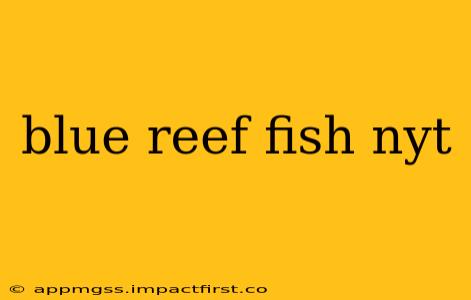The New York Times, while known for its in-depth reporting on global affairs and politics, surprisingly features a fascinating array of aquatic life, including many stunning blue reef fish. While they may not always be the headline, these vibrant creatures often grace the pages (and increasingly, the online articles) of the NYT, enriching articles on marine biology, conservation efforts, and the beauty of our oceans. This exploration delves into the world of blue reef fish as depicted in the NYT, investigating their various species, habitats, and the important role they play in the delicate balance of coral reef ecosystems.
What Types of Blue Reef Fish are Featured in the New York Times?
The NYT's coverage isn't limited to a single species. You might find articles discussing various blue reef fish, depending on the article's focus. Some frequently featured (or implicitly mentioned) types include:
-
Blue Tangs (Paracanthurus hepatus): Famous for their striking bright blue bodies and their role in the popular animated film Finding Nemo, these are often included in discussions about coral reef health and the impacts of climate change.
-
Blue Chromis (Chromis viridis): These small, schooling fish are a common sight on many reefs and often appear in photographic essays or broader pieces on reef biodiversity. Their vibrant blue hue makes them visually striking additions to any underwater scene.
-
Blue Devil Damselfish (Chrysiptera cyaneus): Their intense electric blue color makes them visually captivating. Articles may feature them to illustrate the complex social dynamics and territorial behaviors within reef communities.
-
Various other species: The NYT's coverage is broad; expect to encounter various other blue reef fish, potentially highlighted in scientific articles or photography showcasing the diversity of underwater life. Precise species identification may depend heavily on the context of the article itself.
What Threats Do Blue Reef Fish Face?
Many articles in the NYT touch upon the environmental challenges faced by marine life, including blue reef fish. These threats include:
-
Climate Change: Rising ocean temperatures lead to coral bleaching, destroying the habitat blue reef fish rely on for shelter, food, and reproduction. Ocean acidification also impacts their development and survival.
-
Overfishing: Unsustainable fishing practices deplete fish populations, impacting the balance of the entire ecosystem.
-
Pollution: Runoff from agricultural and industrial activities can contaminate water, harming marine life. Plastic pollution poses a significant risk of entanglement and ingestion.
-
Habitat Destruction: Coastal development and destructive fishing methods directly damage coral reefs, eliminating crucial habitats for blue reef fish.
How are the New York Times Articles on Blue Reef Fish Contributing to Conservation Efforts?
By raising awareness about these vibrant creatures and the challenges they face, the NYT plays a crucial role in driving conservation efforts. Highlighting the beauty and fragility of these ecosystems motivates readers to support conservation initiatives and adopt sustainable practices. Articles often indirectly support conservation by increasing public understanding of the importance of reef ecosystems and the need for their protection.
Where Can I Find More Information on Blue Reef Fish Featured in the New York Times?
The best way to find relevant articles is by directly searching the NYT website using keywords like "blue reef fish," "coral reef fish," or specific species names (e.g., "blue tang NYT"). You can also search using more general terms such as "coral reef conservation" or "climate change impact on marine life," as these often incorporate information about blue reef fish within a broader context.
This exploration offers a glimpse into the world of blue reef fish as seen through the lens of the New York Times. While the focus might not always be solely on these vibrant creatures, their presence within articles emphasizes their importance within the broader ecosystem and highlights the pressing need for conservation efforts to protect these beautiful fish and their delicate habitats.
